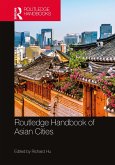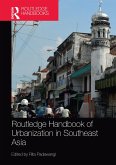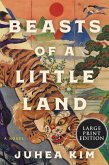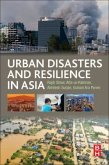Routledge Handbook of Asian Cities
Herausgeber: Hu, Richard
Routledge Handbook of Asian Cities
Herausgeber: Hu, Richard
- Broschiertes Buch
- Merkliste
- Auf die Merkliste
- Bewerten Bewerten
- Teilen
- Produkt teilen
- Produkterinnerung
- Produkterinnerung
This handbook provides the most comprehensive examination of Asian cities - developed and developing, large and small - and their urban development.
Andere Kunden interessierten sich auch für
![Routledge Handbook of Asian Cities Routledge Handbook of Asian Cities]() Routledge Handbook of Asian Cities234,99 €
Routledge Handbook of Asian Cities234,99 €![Legal Empowerment in Informal Settlements Legal Empowerment in Informal Settlements]() Legal Empowerment in Informal Settlements75,99 €
Legal Empowerment in Informal Settlements75,99 €![Routledge Handbook of Urbanization in Southeast Asia Routledge Handbook of Urbanization in Southeast Asia]() Routledge Handbook of Urbanization in Southeast Asia49,99 €
Routledge Handbook of Urbanization in Southeast Asia49,99 €![Somebody Feed Phil the Book Somebody Feed Phil the Book]() Phil RosenthalSomebody Feed Phil the Book22,13 €
Phil RosenthalSomebody Feed Phil the Book22,13 €![How to Stand Up to a Dictator How to Stand Up to a Dictator]() Maria RessaHow to Stand Up to a Dictator15,99 €
Maria RessaHow to Stand Up to a Dictator15,99 €![Beasts of a Little Land Beasts of a Little Land]() Juhea KimBeasts of a Little Land38,99 €
Juhea KimBeasts of a Little Land38,99 €![Urban Disasters and Resilience in Asia Urban Disasters and Resilience in Asia]() Rajib ShawUrban Disasters and Resilience in Asia50,99 €
Rajib ShawUrban Disasters and Resilience in Asia50,99 €-
-
-
This handbook provides the most comprehensive examination of Asian cities - developed and developing, large and small - and their urban development.
Produktdetails
- Produktdetails
- Verlag: Taylor & Francis Ltd
- Seitenzahl: 548
- Erscheinungstermin: 29. November 2024
- Englisch
- Abmessung: 246mm x 174mm x 29mm
- Gewicht: 944g
- ISBN-13: 9781032188416
- ISBN-10: 1032188413
- Artikelnr.: 71911321
- Herstellerkennzeichnung
- Libri GmbH
- Europaallee 1
- 36244 Bad Hersfeld
- gpsr@libri.de
- Verlag: Taylor & Francis Ltd
- Seitenzahl: 548
- Erscheinungstermin: 29. November 2024
- Englisch
- Abmessung: 246mm x 174mm x 29mm
- Gewicht: 944g
- ISBN-13: 9781032188416
- ISBN-10: 1032188413
- Artikelnr.: 71911321
- Herstellerkennzeichnung
- Libri GmbH
- Europaallee 1
- 36244 Bad Hersfeld
- gpsr@libri.de
Richard Hu is an urban planner, designer, and critic. His work and interests-both intellectual and professional-integrate built environment, economy, and technology to tackle contemporary urban transformations and challenges, with a focus on the Asia-Pacific region. He is the author of Smart Design: Disruption, Crisis, and the Reshaping of Urban Spaces (2021).
Part I: Introduction 1. Urban Asia in perspective 2. Smart cities in Asia:
Ambiguity, innovation, and evolution 3. Asian cities in and beyond COVID-19
4. Vulnerable resilience in COVID-19: Invisibility and adaptability of the
'informal' cities of Southeast Asia 5. Making liveable cities: Experiences
from Asia and the Pacific Part II: East Asian cities 6. East Asian cities:
Deindustrialisation, greening, and the new geography of urbanisation 7.
Hong Kong: One city, three spatial forms, and two possible fates? 8.
Pyongyang: An urban metamorphosis under the power of marketisation 9.
Seoul: Pursuing and sharing a global city 10. Shanghai: New directions in
Chinese metropolitan planning 11. Taipei: Towards a liveable and
sustainable city 12. Tokyo: Reinventing the modern Asian metropolis through
adaptive strategies 13. Ulaanbaatar: When international plans and local
preferences over urban densification collide 14. Xi'an: From an ancient
world city to a 21st-century global logistics centre Part III: South Asian
cities 15. South Asian cities: Informalisation of ecological and social
change 16. Colombo: From colonial outpost to indigenous kleptocratic city
17. Delhi: Rethinking Indian urbanism through the capital's multi-nuclei
development 18. Dhaka: Growth management challenges for a rapidly
urbanising megacity 19. Kabul: The 21st century urbanism we did not expect
20. Karachi: Changing institutional landscapes, challenges, and reforms 21.
Kathmandu Valley: Unrealised proposals, decades of urban chaos and planning
for a better future 22. Malé: Decentralising the world's densest island
capital-plans, determination, and challenges 23. Mumbai: 'Mess is
more'-value and shortcomings of the city's ad hoc development process 24.
Thimphu: Tranquil, peace, and happy city of the Himalayas Part IV:
Southeast Asian cities 25. Southeast Asian cities: The imbalances of urban
development 26. Bandar Seri Begawan: Why is Brunei's capital chasing
foreign dollars? 27. Bangkok: Creative disorder and the military
imagination 28. Dili: Hurdles in constructing the urban from the ground 29.
Ho Chi Minh City: Can it avoid the path dependence with Thu Duc City? 30.
Jakarta: Seeking the sustainable megacity region 31. Kuala Lumpur:
Post-Vision 2020 and post-pandemic futures 32. Manila: Aspiring to be an
inclusive, resilient, and sustainable city amidst climate and disaster
risks 33. Phnom Penh: Towards a post-dependency metropolisation? 34.
Singapore: Planning for healthy ageing 35. Vientiane: Challenges in the
policies and practices for sustainable urban development in a 'least
developed' city 36. Yangon: Displacement urbanism, housing provisionality,
and feminist spatial practices-an infrastructure of care at the urban
margin Part V: Central Asian cities 37. Central Asian cities: Challenges in
balancing global, national, and local development needs 38. Almaty:
Modernisation through spatial reordering-urban networks, transport sector
reforms, and Eurasianism 39. Ashgabat: The architecture as a showcase of a
personal regime 40. Bishkek: Searching for Asianness in a post-Soviet city
41. Dushanbe: Urban transformation, changing spaces, and identities in
Tajikistan 42. Tashkent: Aspiring for entrepreneurship and innovation hub
Part VI: Conclusion 43. The Asian city in a new urban age
Ambiguity, innovation, and evolution 3. Asian cities in and beyond COVID-19
4. Vulnerable resilience in COVID-19: Invisibility and adaptability of the
'informal' cities of Southeast Asia 5. Making liveable cities: Experiences
from Asia and the Pacific Part II: East Asian cities 6. East Asian cities:
Deindustrialisation, greening, and the new geography of urbanisation 7.
Hong Kong: One city, three spatial forms, and two possible fates? 8.
Pyongyang: An urban metamorphosis under the power of marketisation 9.
Seoul: Pursuing and sharing a global city 10. Shanghai: New directions in
Chinese metropolitan planning 11. Taipei: Towards a liveable and
sustainable city 12. Tokyo: Reinventing the modern Asian metropolis through
adaptive strategies 13. Ulaanbaatar: When international plans and local
preferences over urban densification collide 14. Xi'an: From an ancient
world city to a 21st-century global logistics centre Part III: South Asian
cities 15. South Asian cities: Informalisation of ecological and social
change 16. Colombo: From colonial outpost to indigenous kleptocratic city
17. Delhi: Rethinking Indian urbanism through the capital's multi-nuclei
development 18. Dhaka: Growth management challenges for a rapidly
urbanising megacity 19. Kabul: The 21st century urbanism we did not expect
20. Karachi: Changing institutional landscapes, challenges, and reforms 21.
Kathmandu Valley: Unrealised proposals, decades of urban chaos and planning
for a better future 22. Malé: Decentralising the world's densest island
capital-plans, determination, and challenges 23. Mumbai: 'Mess is
more'-value and shortcomings of the city's ad hoc development process 24.
Thimphu: Tranquil, peace, and happy city of the Himalayas Part IV:
Southeast Asian cities 25. Southeast Asian cities: The imbalances of urban
development 26. Bandar Seri Begawan: Why is Brunei's capital chasing
foreign dollars? 27. Bangkok: Creative disorder and the military
imagination 28. Dili: Hurdles in constructing the urban from the ground 29.
Ho Chi Minh City: Can it avoid the path dependence with Thu Duc City? 30.
Jakarta: Seeking the sustainable megacity region 31. Kuala Lumpur:
Post-Vision 2020 and post-pandemic futures 32. Manila: Aspiring to be an
inclusive, resilient, and sustainable city amidst climate and disaster
risks 33. Phnom Penh: Towards a post-dependency metropolisation? 34.
Singapore: Planning for healthy ageing 35. Vientiane: Challenges in the
policies and practices for sustainable urban development in a 'least
developed' city 36. Yangon: Displacement urbanism, housing provisionality,
and feminist spatial practices-an infrastructure of care at the urban
margin Part V: Central Asian cities 37. Central Asian cities: Challenges in
balancing global, national, and local development needs 38. Almaty:
Modernisation through spatial reordering-urban networks, transport sector
reforms, and Eurasianism 39. Ashgabat: The architecture as a showcase of a
personal regime 40. Bishkek: Searching for Asianness in a post-Soviet city
41. Dushanbe: Urban transformation, changing spaces, and identities in
Tajikistan 42. Tashkent: Aspiring for entrepreneurship and innovation hub
Part VI: Conclusion 43. The Asian city in a new urban age
Part I: Introduction 1. Urban Asia in perspective 2. Smart cities in Asia:
Ambiguity, innovation, and evolution 3. Asian cities in and beyond COVID-19
4. Vulnerable resilience in COVID-19: Invisibility and adaptability of the
'informal' cities of Southeast Asia 5. Making liveable cities: Experiences
from Asia and the Pacific Part II: East Asian cities 6. East Asian cities:
Deindustrialisation, greening, and the new geography of urbanisation 7.
Hong Kong: One city, three spatial forms, and two possible fates? 8.
Pyongyang: An urban metamorphosis under the power of marketisation 9.
Seoul: Pursuing and sharing a global city 10. Shanghai: New directions in
Chinese metropolitan planning 11. Taipei: Towards a liveable and
sustainable city 12. Tokyo: Reinventing the modern Asian metropolis through
adaptive strategies 13. Ulaanbaatar: When international plans and local
preferences over urban densification collide 14. Xi'an: From an ancient
world city to a 21st-century global logistics centre Part III: South Asian
cities 15. South Asian cities: Informalisation of ecological and social
change 16. Colombo: From colonial outpost to indigenous kleptocratic city
17. Delhi: Rethinking Indian urbanism through the capital's multi-nuclei
development 18. Dhaka: Growth management challenges for a rapidly
urbanising megacity 19. Kabul: The 21st century urbanism we did not expect
20. Karachi: Changing institutional landscapes, challenges, and reforms 21.
Kathmandu Valley: Unrealised proposals, decades of urban chaos and planning
for a better future 22. Malé: Decentralising the world's densest island
capital-plans, determination, and challenges 23. Mumbai: 'Mess is
more'-value and shortcomings of the city's ad hoc development process 24.
Thimphu: Tranquil, peace, and happy city of the Himalayas Part IV:
Southeast Asian cities 25. Southeast Asian cities: The imbalances of urban
development 26. Bandar Seri Begawan: Why is Brunei's capital chasing
foreign dollars? 27. Bangkok: Creative disorder and the military
imagination 28. Dili: Hurdles in constructing the urban from the ground 29.
Ho Chi Minh City: Can it avoid the path dependence with Thu Duc City? 30.
Jakarta: Seeking the sustainable megacity region 31. Kuala Lumpur:
Post-Vision 2020 and post-pandemic futures 32. Manila: Aspiring to be an
inclusive, resilient, and sustainable city amidst climate and disaster
risks 33. Phnom Penh: Towards a post-dependency metropolisation? 34.
Singapore: Planning for healthy ageing 35. Vientiane: Challenges in the
policies and practices for sustainable urban development in a 'least
developed' city 36. Yangon: Displacement urbanism, housing provisionality,
and feminist spatial practices-an infrastructure of care at the urban
margin Part V: Central Asian cities 37. Central Asian cities: Challenges in
balancing global, national, and local development needs 38. Almaty:
Modernisation through spatial reordering-urban networks, transport sector
reforms, and Eurasianism 39. Ashgabat: The architecture as a showcase of a
personal regime 40. Bishkek: Searching for Asianness in a post-Soviet city
41. Dushanbe: Urban transformation, changing spaces, and identities in
Tajikistan 42. Tashkent: Aspiring for entrepreneurship and innovation hub
Part VI: Conclusion 43. The Asian city in a new urban age
Ambiguity, innovation, and evolution 3. Asian cities in and beyond COVID-19
4. Vulnerable resilience in COVID-19: Invisibility and adaptability of the
'informal' cities of Southeast Asia 5. Making liveable cities: Experiences
from Asia and the Pacific Part II: East Asian cities 6. East Asian cities:
Deindustrialisation, greening, and the new geography of urbanisation 7.
Hong Kong: One city, three spatial forms, and two possible fates? 8.
Pyongyang: An urban metamorphosis under the power of marketisation 9.
Seoul: Pursuing and sharing a global city 10. Shanghai: New directions in
Chinese metropolitan planning 11. Taipei: Towards a liveable and
sustainable city 12. Tokyo: Reinventing the modern Asian metropolis through
adaptive strategies 13. Ulaanbaatar: When international plans and local
preferences over urban densification collide 14. Xi'an: From an ancient
world city to a 21st-century global logistics centre Part III: South Asian
cities 15. South Asian cities: Informalisation of ecological and social
change 16. Colombo: From colonial outpost to indigenous kleptocratic city
17. Delhi: Rethinking Indian urbanism through the capital's multi-nuclei
development 18. Dhaka: Growth management challenges for a rapidly
urbanising megacity 19. Kabul: The 21st century urbanism we did not expect
20. Karachi: Changing institutional landscapes, challenges, and reforms 21.
Kathmandu Valley: Unrealised proposals, decades of urban chaos and planning
for a better future 22. Malé: Decentralising the world's densest island
capital-plans, determination, and challenges 23. Mumbai: 'Mess is
more'-value and shortcomings of the city's ad hoc development process 24.
Thimphu: Tranquil, peace, and happy city of the Himalayas Part IV:
Southeast Asian cities 25. Southeast Asian cities: The imbalances of urban
development 26. Bandar Seri Begawan: Why is Brunei's capital chasing
foreign dollars? 27. Bangkok: Creative disorder and the military
imagination 28. Dili: Hurdles in constructing the urban from the ground 29.
Ho Chi Minh City: Can it avoid the path dependence with Thu Duc City? 30.
Jakarta: Seeking the sustainable megacity region 31. Kuala Lumpur:
Post-Vision 2020 and post-pandemic futures 32. Manila: Aspiring to be an
inclusive, resilient, and sustainable city amidst climate and disaster
risks 33. Phnom Penh: Towards a post-dependency metropolisation? 34.
Singapore: Planning for healthy ageing 35. Vientiane: Challenges in the
policies and practices for sustainable urban development in a 'least
developed' city 36. Yangon: Displacement urbanism, housing provisionality,
and feminist spatial practices-an infrastructure of care at the urban
margin Part V: Central Asian cities 37. Central Asian cities: Challenges in
balancing global, national, and local development needs 38. Almaty:
Modernisation through spatial reordering-urban networks, transport sector
reforms, and Eurasianism 39. Ashgabat: The architecture as a showcase of a
personal regime 40. Bishkek: Searching for Asianness in a post-Soviet city
41. Dushanbe: Urban transformation, changing spaces, and identities in
Tajikistan 42. Tashkent: Aspiring for entrepreneurship and innovation hub
Part VI: Conclusion 43. The Asian city in a new urban age








